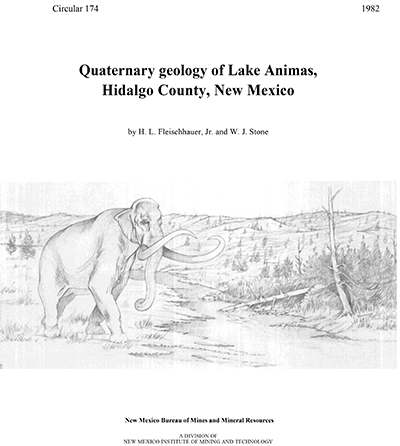
Circular 174—Quaternary geology of Lake Animas, Hidalgo County, New Mexico
By H. L. Fleischhauer, Jr. and W. J. Stone, 1982, 25 pp., 4 tables, 12 figs., appendix, 1 sheet.

This study describes the geomorphology, soil stratigraphy, and ages for Lake Animas in Hidalgo County, New Mexico. The mapping of the shoreline features in the lower Animas Valley indicates three stages for Lake Animas. Most of the shorelines are marked by low ridges that consist of homogeneous sand and gravel deposited on beaches. Haplargids and Camborthids have developed on the shoreline deposits. An inferred Holocene age for the two low shorelines is consistent with radiocarbon chronologies of other western lake basins and with local and regional paleoclimate reconstructions. The age of the soil and material of the high shore ridge is probably Pleistocene.
At least three small lakes occupied closed intermontane valleys in southwest New Mexico during the late Quaternary. The largest of these, Lake Animas, is the most continuous and best preserved shoreline features. The lacustrine origin of these features was first recognized by Schwennesen who traced them around the playas in the lower end of the Animas Valley. However, he postulates a high-stage elevation of 4,390 ft on the basis of ridges near Animas, New Mexico, approximately 20 mi south of the playas. A lake at this level would have submerged the divide at Summit railroad siding to a depth of 150 ft and would have extended far into the Duncan Basin to the north.
The mapping of shoreline features on the Lower Animas Valley indicates three
stages for Lake Animas. Estimated elevations of the high, intermediate,
and low shorelines are 4,190–4,195 ft, 4,185 ft, and 4,175–4,180
ft, respectively. At an elevation of 4,195 ft Lake Animas was approximately
17 mi long, 8 mi wide, 50 ft deep, and covered approximately 150 mi2. Most
of the shorelines are marked by low ridges that consist of homogeneous sand
and gravel deposited on beaches. The stratigraphy of thicker sections suggests
the presence of offshore bars and barriers along some stretches of the low
shore ridge and further suggests that these stretches of the low shore ridge
may have formed during higher stages of the lake. Haplargids and Camborthids
have developed on the shoreline deposits. The low and intermediate shorelines
have identical soils with morphologies comparable to Holocene soils in the
Las Cruces area. A Holocene age for soils of these two shorelines is supported
by limited archeological evidence; the inferred Holocene age for Lake Animas
at these levels is consistent with radiocarbon chronologies of other western
lake basins and with local and regional paleoclimate reconstructions. The
age of the soil and material of the high shore ridge is probably Pleistocene.
$8.00
Buy
Now
Also available as a free download.
Download
| File Name | Size | Last Modified |
|---|---|---|
| Circular-174.pdf | 3.91 MB | 01/11/2021 03:38:53 PM |



